Choosing a Gaming CPU at 1440p: Adding in Haswell
by Ian Cutress on June 4, 2013 10:00 AM ESTCPU Benchmarks
Point Calculations - 3D Movement Algorithm Test
The algorithms in 3DPM employ both uniform random number generation or normal distribution random number generation, and vary in amounts of trigonometric operations, conditional statements, generation and rejection, fused operations, etc. The benchmark runs through six algorithms for a specified number of particles and steps, and calculates the speed of each algorithm, then sums them all for a final score. This is an example of a real world situation that a computational scientist may find themselves in, rather than a pure synthetic benchmark. The benchmark is also parallel between particles simulated, and we test the single threaded performance as well as the multi-threaded performance.
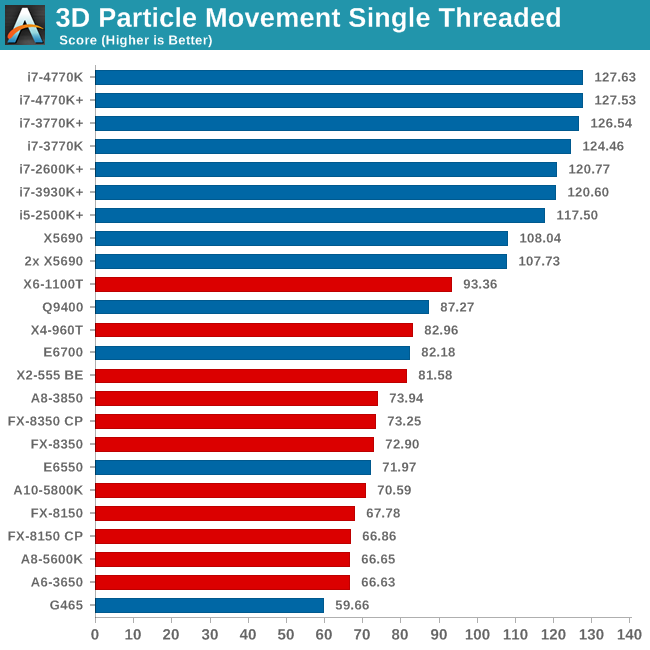
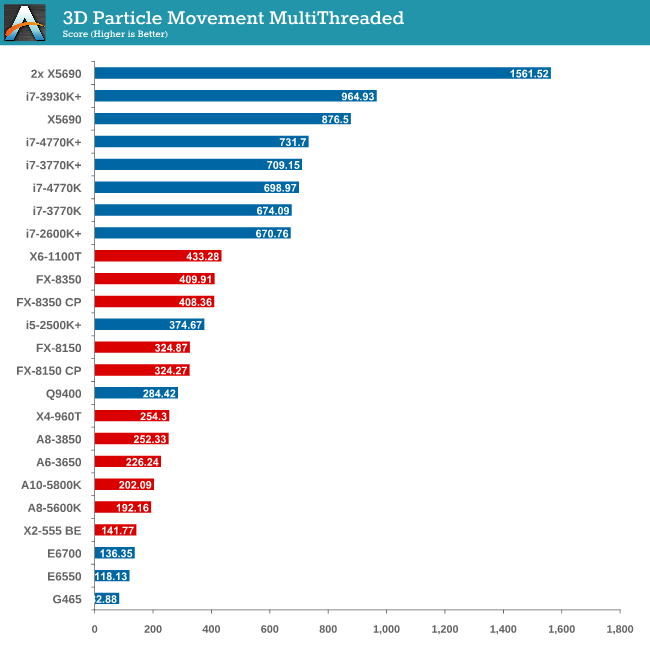
As mentioned in previous reviews, this benchmark is written how most people would tackle the situation – using floating point numbers. This is also where Intel excels, compared to AMD’s decision to move more towards INT ops (such as hashing), which is typically linked to optimized code or normal OS behavior.
The 4770K comes in top in single threaded performance, showcasing the IPC gains of the new architecture. This is also shown in multithreaded tests with MCT both off and on.
Compression - WinRAR x64 3.93 + WinRAR 4.2
With 64-bit WinRAR, we compress the set of files used in our motherboard USB speed tests. WinRAR x64 3.93 attempts to use multithreading when possible and provides a good test for when a system has variable threaded load. WinRAR 4.2 does this a lot better! If a system has multiple speeds to invoke at different loading, the switching between those speeds will determine how well the system will do.
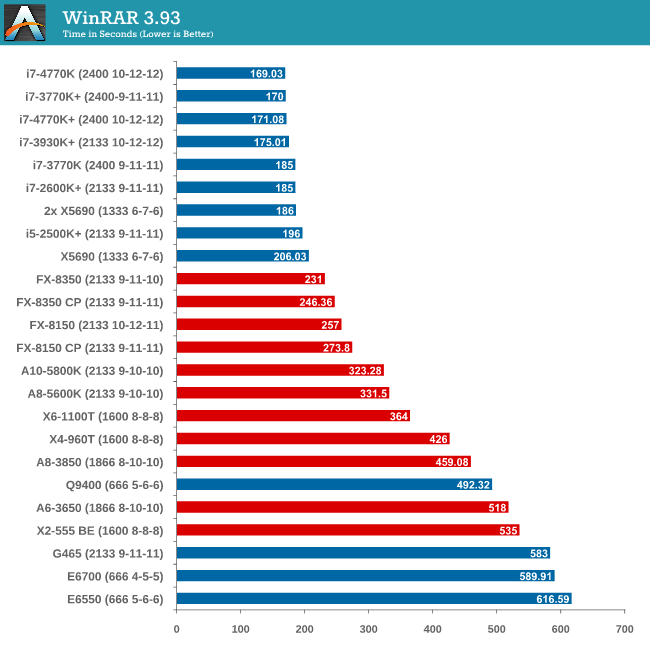
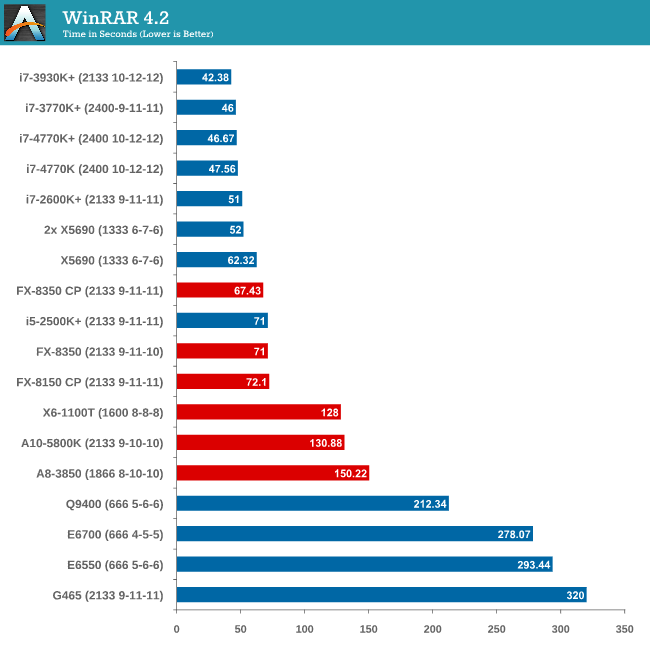
Due to the late inclusion of 4.2, our results list for it is a little smaller than I would have hoped. But it is interesting to note that with the Core Parking updates, an FX-8350 overtakes an i5-2500K with MCT.
Image Manipulation - FastStone Image Viewer 4.2
FastStone Image Viewer is a free piece of software I have been using for quite a few years now. It allows quick viewing of flat images, as well as resizing, changing color depth, adding simple text or simple filters. It also has a bulk image conversion tool, which we use here. The software currently operates only in single-thread mode, which should change in later versions of the software. For this test, we convert a series of 170 files, of various resolutions, dimensions and types (of a total size of 163MB), all to the .gif format of 640x480 dimensions.
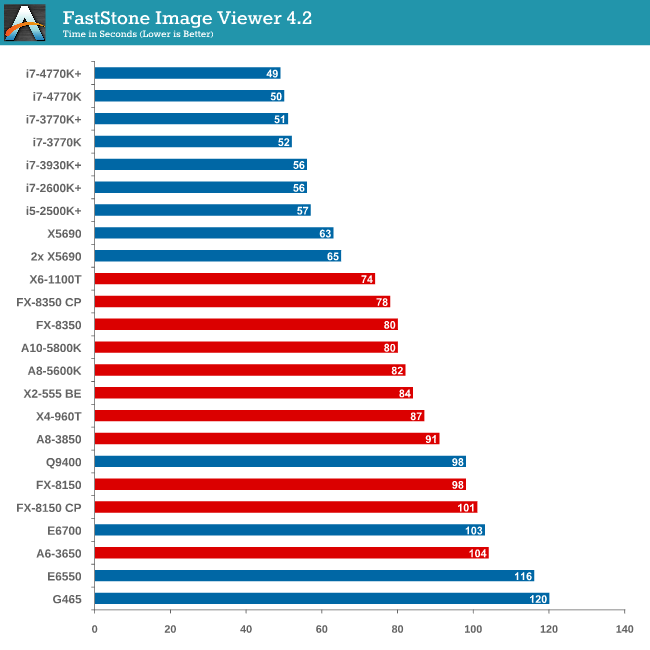
In terms of pure single thread speed, it is worth noting the X6-1100T is leading the AMD pack, and the 4770K takes the top spot. .
Video Conversion - Xilisoft Video Converter 7
With XVC, users can convert any type of normal video to any compatible format for smartphones, tablets and other devices. By default, it uses all available threads on the system, and in the presence of appropriate graphics cards, can utilize CUDA for NVIDIA GPUs as well as AMD WinAPP for AMD GPUs. For this test, we use a set of 33 HD videos, each lasting 30 seconds, and convert them from 1080p to an iPod H.264 video format using just the CPU. The time taken to convert these videos gives us our result.
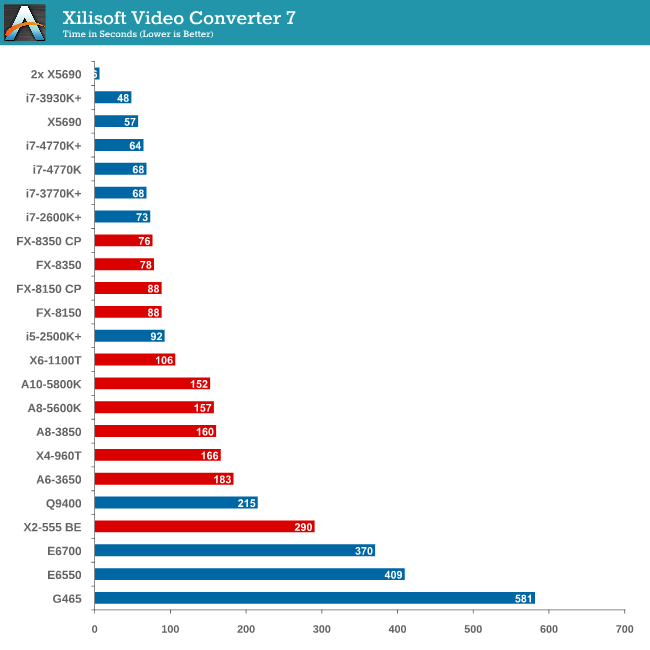
XVC is a little odd in how it arranges its multicore processing. For our set of 33 videos, it will arrange them in batches of threads – so if we take the 8 thread FX-8350, it will arrange the videos into 4 batches of 8, and then a fifth batch of one. That final batch will only have one thread assigned to it (!), and will not get a full 8 threads worth of power. This is also why the 2x X5690 finishes in 6 seconds but the normal X5690 takes longer – you would expect a halving of time moving to two CPUs but XVC arranges the batches such that there is always one at the end that only gets a single thread.
Rendering – PovRay 3.7
The Persistence of Vision RayTracer, or PovRay, is a freeware package for as the name suggests, ray tracing. It is a pure renderer, rather than modeling software, but the latest beta version contains a handy benchmark for stressing all processing threads on a platform. We have been using this test in motherboard reviews to test memory stability at various CPU speeds to good effect – if it passes the test, the IMC in the CPU is stable for a given CPU speed. As a CPU test, it runs for approximately 2-3 minutes on high end platforms.
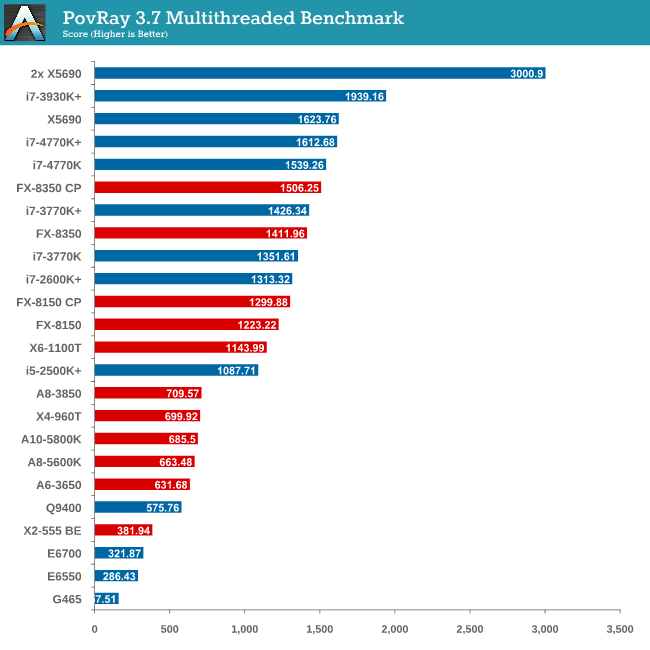
The SMP engine in PovRay is not perfect, though scaling up in CPUs gives almost a 2x effect. The results from this test are great – here we see an FX-8350 CPU below an i7-3770K (with MCT), until the Core Parking updates are applied, meaning the FX-8350 performs better! The 4770K also has a chance to flex its compute muscles, performing almost as well as the 8-core Westmere CPU.
Video Conversion - x264 HD Benchmark
The x264 HD Benchmark uses a common HD encoding tool to process an HD MPEG2 source at 1280x720 at 3963 Kbps. This test represents a standardized result which can be compared across other reviews, and is dependent on both CPU power and memory speed. The benchmark performs a 2-pass encode, and the results shown are the average of each pass performed four times.
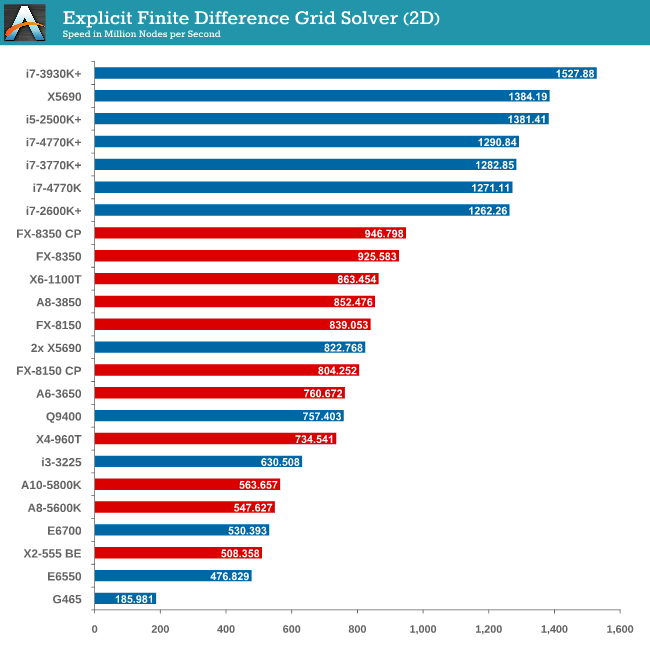
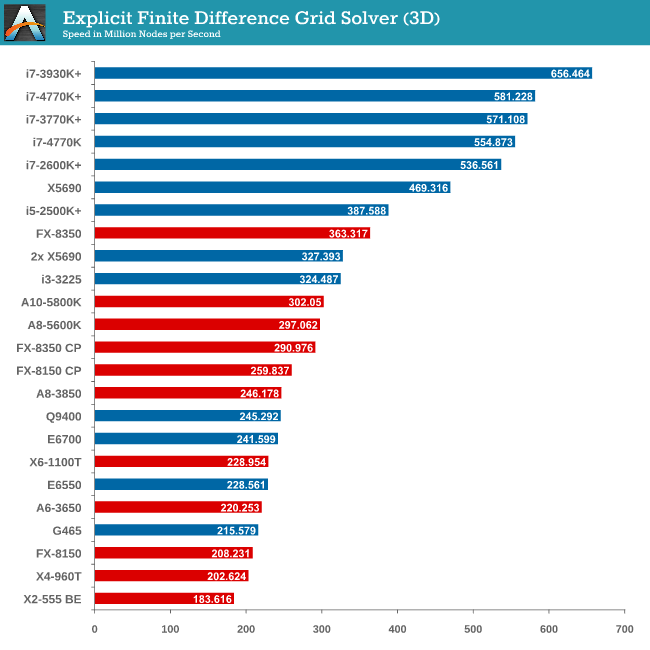
Grid Solvers - Explicit Finite Difference
For any grid of regular nodes, the simplest way to calculate the next time step is to use the values of those around it. This makes for easy mathematics and parallel simulation, as each node calculated is only dependent on the previous time step, not the nodes around it on the current calculated time step. By choosing a regular grid, we reduce the levels of memory access required for irregular grids. We test both 2D and 3D explicit finite difference simulations with 2n nodes in each dimension, using OpenMP as the threading operator in single precision. The grid is isotropic and the boundary conditions are sinks. Values are floating point, with memory cache sizes and speeds playing a part in the overall score.
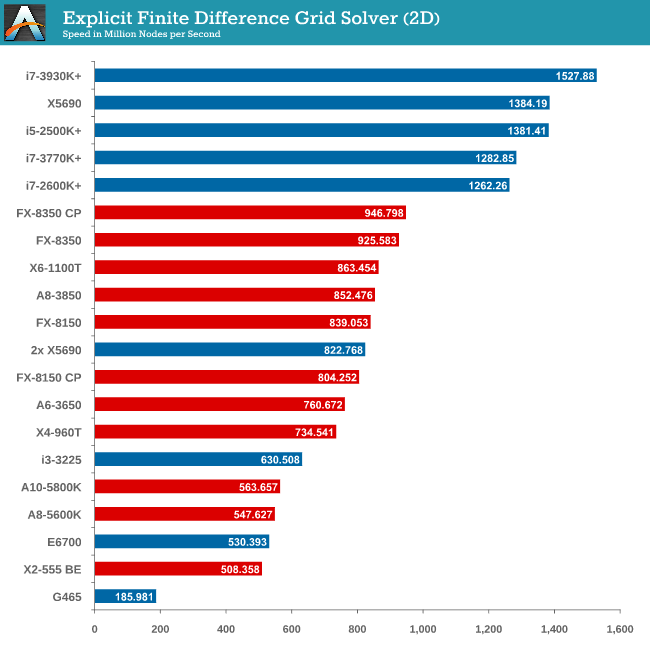
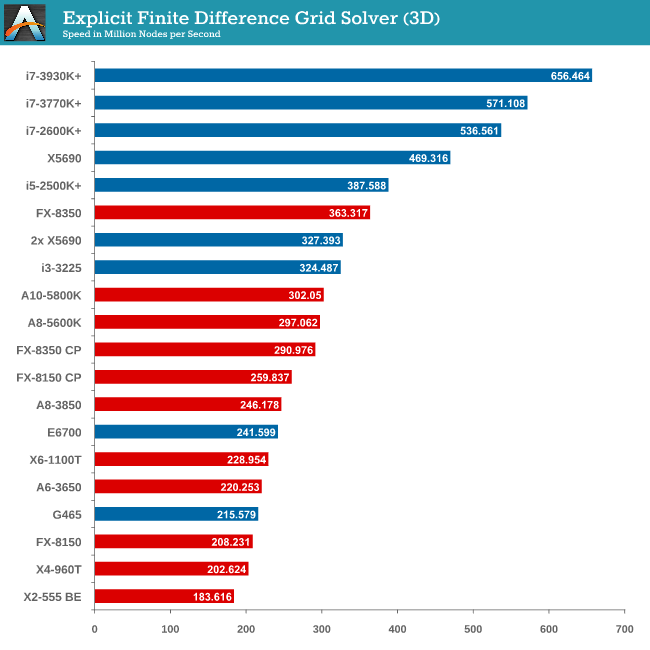
Grid solvers do love a fast processor and plenty of cache in order to store data. When moving up to 3D, it is harder to keep that data within the CPU and spending extra time coding in batches can help throughput. Our simulation takes a very naïve approach in code, using simple operations.
Grid Solvers - Implicit Finite Difference + Alternating Direction Implicit Method
The implicit method takes a different approach to the explicit method – instead of considering one unknown in the new time step to be calculated from known elements in the previous time step, we consider that an old point can influence several new points by way of simultaneous equations. This adds to the complexity of the simulation – the grid of nodes is solved as a series of rows and columns rather than points, reducing the parallel nature of the simulation by a dimension and drastically increasing the memory requirements of each thread. The upside, as noted above, is the less stringent stability rules related to time steps and grid spacing. For this we simulate a 2D grid of 2n nodes in each dimension, using OpenMP in single precision. Again our grid is isotropic with the boundaries acting as sinks. Values are floating point, with memory cache sizes and speeds playing a part in the overall score.
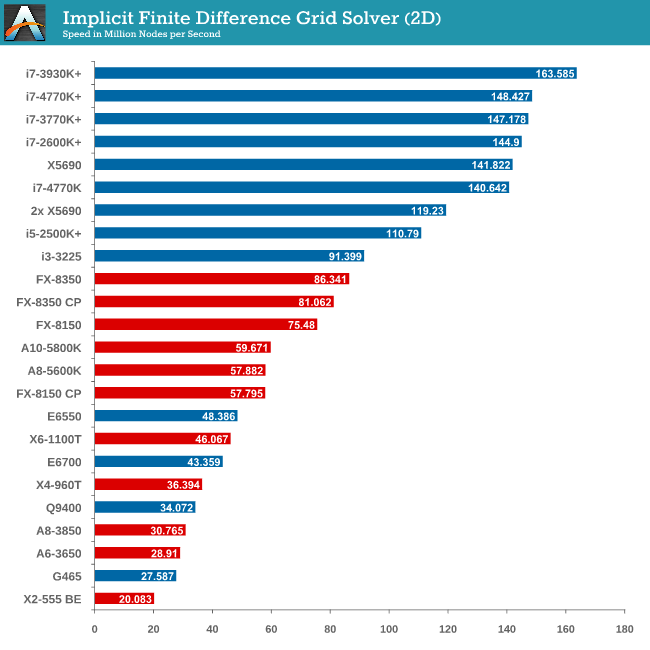
2D Implicit is harsher than an Explicit calculation – each thread needs more a lot memory, which only ever grows as the size of the simulation increases.
Point Calculations - n-Body Simulation
When a series of heavy mass elements are in space, they interact with each other through the force of gravity. Thus when a star cluster forms, the interaction of every large mass with every other large mass defines the speed at which these elements approach each other. When dealing with millions and billions of stars on such a large scale, the movement of each of these stars can be simulated through the physical theorems that describe the interactions. The benchmark detects whether the processor is SSE2 or SSE4 capable, and implements the relative code. We run a simulation of 10240 particles of equal mass - the output for this code is in terms of GFLOPs, and the result recorded was the peak GFLOPs value.
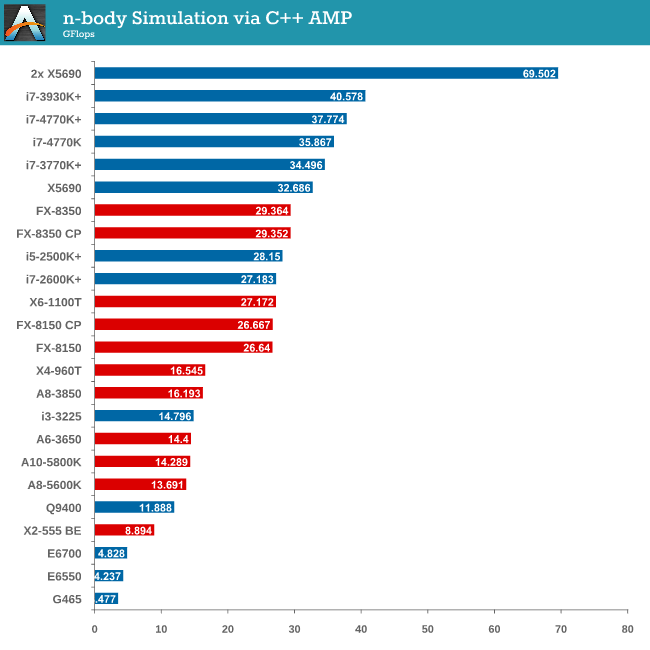
As we only look at base/SSE2/SSE4 depending on the processor (auto-detection), we don’t see full AVX numbers in terms of FLOPs.










116 Comments
View All Comments
TheJian - Sunday, June 9, 2013 - link
The comparison doesn't make sense. This is about making false claims and misrepresenting data. What does that have to do with linux? Come back when you have a decent argument about the data in question here.UltraTech79 - Saturday, June 22, 2013 - link
Thats a pretty shitty point.Jon Irenicus - Sunday, June 16, 2013 - link
who cares what most of the market has, 1440p monitors are in the 300 dollar range from the korean ebay sellers, just because a bunch of no nothings did not get the memo and get one of those better monitors and spent all their cash upgrading their cpu/gpus with their crap 1080p monitors does not mean reviews should not focus on where people SHOULD go.1080p is a garbage resolution for large displays when you have easy and CHEAP access to 1440p. I got one of those monitors, it's beautiful. The problem is not the 4% that are higher than 1080/1200p, is the rest of you who are too cpu focused to get a better monitor.
I mean jesus people, you sit and stare at that thing ALL DAMN DAY, and people actually spend HUNDREDS of dollars on multi gpu setups and high end cpus to game at 1080p... it's submental. YOU and others need to stop complaining about a lack of focus on 1080p, and get on board the 1440p train. You don't have that? well get it, stop lagging, you are choosing an inferior setup and complaining to anandtech because they chose not to focus on your crap resolution monitor?
It's almost as if you specifically cripple your gaming resolution just so you can feel more satisfied at how much faster the intel cpus beat out the amds. Well, you're right, they do, and you still chose an inferior gaming resolution, stop living in the ghetto of the pc gaming world and move higher.
UltraTech79 - Saturday, June 22, 2013 - link
I stopped reading at "no nothings". Lol what a ranting lunatic.metasyStratS - Thursday, June 6, 2013 - link
"This is another attempt at covering for AMD and trying to help them sell products... Anandtech is MISLEADING you at best by showing a resolution higher than 98.75% of us are using and tapping out the single gpu..."You could also easily argue that the article is helping to sell Intel's 4770K, providing data that misleadingly (though not falsely) indicates the superiority of the 4770K over the 2500K/3770K group.
For the majority gamers, it is indeed misleading to focus on 1440p only. For a good number, it is also misleading to focus only on stock clocks.
As you point out, at 1080p, overclocking does help (though the benefit has to be weighed against the cost of upgraded cooling). As as others in forums have pointed out, 2700K vs. 3770K is roughly equal: with any given aftermarket cooler, a 3770K at 'Maximum Stable Overclock' will have roughly the same performance as a 2700K at 'Maximum Stable Overclock', will run hotter than a 2700K, but will consume less energy, and so on...
On the other hand, preliminary indications are that for the majority of overclockers (those who do not want to spend as much for a custom water-cooling loop as for the CPU itself), a 4770K is a worse bet, as it apparently runs hotter than even the 3770K, and the gains in 'Instructions per Clock' likely do not make up for what would thus be a reduced 'Maximum Stable Overclock.' See here: http://forums.pureoverclock.com/cpu-overclocking/2...
In short: CPU overclocking yields a tangible benefit for 1080p gamers, and for the majority of CPU Overclockers (those who do not want to spend as much for a custom water-cooling loop as for the CPU itself), the 4770K appears to be something LESS than a 3770K or 2700K.
TheJian - Thursday, June 6, 2013 - link
I didn't say anything about overclocking. Maybe one of the quotes did? My statements are pure chip to chip, no overclocking discussed. Maybe you were replying to someone else?The article is isn't helping to sell 4770k's when he says single gpu owners (98% according to steampowered survey) can play fine on a A8-5600. Single GPU owners again, according to the survey are NOT running above 1920x1200. So AMD gets killed unless you pull a stunt like anandtech did here as the benchmarks in the links I pointed to show.
I did not point out overclocking at 1080p helps. I made no statement regarding overclocking, but Intel wins that anyway.
Obsoleet - Thursday, June 6, 2013 - link
DOWN WITH THE 1.25%!!Calinou__ - Friday, June 7, 2013 - link
Fun fact: the A10-5800K's upside is its IGP, not the processor part.If you want to do gaming with an AMD CPU you better pick a FX-6xxx or a FX-8xxx.
leon park - Saturday, November 14, 2020 - link
<a href="https://getmecrack.com/simplify3d-torrent-license-... Simplify 3D Torrent </a>Have You Seen These Amazing Links Check it out Please
<a href="https://portabledownloads.com/autodesk-3ds-max-202... Auto Desk 3ds </a>
dishayu - Tuesday, June 4, 2013 - link
I'm sorry if i missed this info while reading but does Haswell come with dual link DVI support? You know, so that i can drive my 1440p displays for everyday usage, since i don't game all that much.